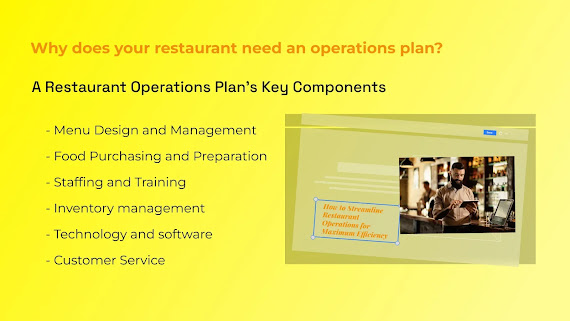Front Of House (Foh) Vs. Back Of House (Boh): What’s The Difference?
In the intricate world of restaurants, a fundamental division exists – the distinction between Front of House (FOH) and Back of House (BOH). FOH relates to everything seen by guests, while BOH encompasses the unseen, behind-the-scenes operations. Both are pivotal cogs in the restaurant machinery, working harmoniously to ensure a seamless dining experience.
Front of House :
So, what exactly constitutes the Front of House and what unfolds there? FOH includes all the spaces in a restaurant that set the stage for the customer's journey. It's where your front-of-house staff operates, those individuals who directly interact with customers, influencing their dining experience. To craft a memorable experience, every FOH team member collaborates to provide exceptional service to each guest.
Exploring Front-of-House Areas:
FOH, being the customer-facing aspect of the restaurant, includes:
Entryway: Where guests first encounter your restaurant's ambiance and vibe, creating that vital first impression.
Waiting Area: A comfortable space for patrons while their table is prepared.
Bar Area: Ideal for guest interaction and upselling drinks before dining.
Dining Room: The core of the dining experience where customers connect with the front-of-house staff, particularly servers.
Restrooms: A crucial but often overlooked touchpoint for guests, necessitating cleanliness and tidiness.
Patio Seating: An appealing outdoor dining area, especially in the summer, enhancing the overall ambiance.
Shedding Light on Front of House Positions:
FOH staff, bridging the gap between guests and the kitchen, are versatile in their roles:
General Manager: The linchpin overseeing the restaurant's entire operation, vital for ensuring smooth operations and customer satisfaction.
Front of House Manager: Reporting to the General Manager, they manage all FOH employees, from hiring to handling customer concerns.
Headwaiter: Directs the wait staff, hosts, and bussers, providing top-tier customer service while supervising their own tables.
Bartender: The drink maestro entrusted with crafting the perfect beverage and, often, serving food.
Server: The face of the restaurant, answering questions, taking orders, and connecting with the kitchen.
Food Runner: Ensures swift, hot food delivery, catering to customer needs, and occasionally interacting with guests.
Bar-Back: The bartender's right hand in maintaining a well-stocked bar.
Busser: Sets tables and handles dish cleanup, requiring a professional demeanor for guest-facing duties.
Embracing Front of House Technology:
Front-of-house technology underpins the efficiency of these roles, enhancing the overall customer experience, minimizing wait times, and preventing order errors.
Vital components include:
Point-of-Sale (POS) System: The heart of restaurant operations, optimizing orders, payments, and menu management.
Payment Systems: Offering various payment options, integrating with POS for faster and error-free transactions.
Self-Order Kiosks: A boon during staff shortages, allowing guests to order and pay independently.
Back of House:
The Back of House, often hidden from guests, is where culinary magic happens. This realm encompasses all activities, staff, technology, and spaces that ensure the restaurant runs smoothly.
Exploring Back of House Areas:
BOH covers areas unseen by diners, including:
Kitchen: The heart of the restaurant, where orders are prepared, ingredients stored, and dishes cleaned.
Administrative Areas: Handling operations behind the scenes, maintaining efficiency.
Staff Breakroom: Provides employees with a space to relax, an example of BOH areas catering to staff needs.
Illuminating Back of House Positions:
Roles in the BOH include:
Kitchen Manager: Overseeing BOH workers, ensuring safety standards, staffing, and aiding where needed.
Executive Chef/Head Chef: Planning menus, managing expenses, ordering food, and performing administrative tasks.
Sous Chef: Assisting the head chef, supervising the kitchen crew, training staff, and taking charge in the head chef's absence.
Line Cooks: Stationed in the kitchen, responsible for various food types and preparation.
Expeditor: Orchestrates orders, possessing deep knowledge of the menu.
Dishwasher: Manages dish and glassware cleaning.
Back of House Technology Revealed:
Back-of-house technology enhances BOH efficiency, expediting orders, improving communication between kitchen staff, and maximizing profitability.
Key components include:
Kitchen Display System: Streamlining communication and reducing order creation times.
Back Office Software: Essential for inventory management, shipping, receiving, and profit maximization.
The Fusion of Front and Back of House:
Restaurant technology plays a pivotal role in connecting FOH and BOH, streamlining communication and aligning efforts. Common technologies include Table Management Systems, POS Systems, and Kitchen Display Systems, ensuring a cohesive dining experience.
FAQs on FOH vs. BOH:
Which is more challenging: BOH or FOH?
It varies depending on the work and individual experiences. BOH positions are typically physically demanding, focusing on stock management. FOH positions, on the other hand, require strong customer service skills and regular interactions with diners.
What distinguishes FOH from BOH?
FOH staff prioritize customer experience and the overall ambiance, while BOH staff handle non-customer-facing activities, especially in the kitchen.
%20vs.%20Back%20of%20House%20(BOH)_%20%20What%E2%80%99s%20the%20Difference_.webp)



Comments
Post a Comment